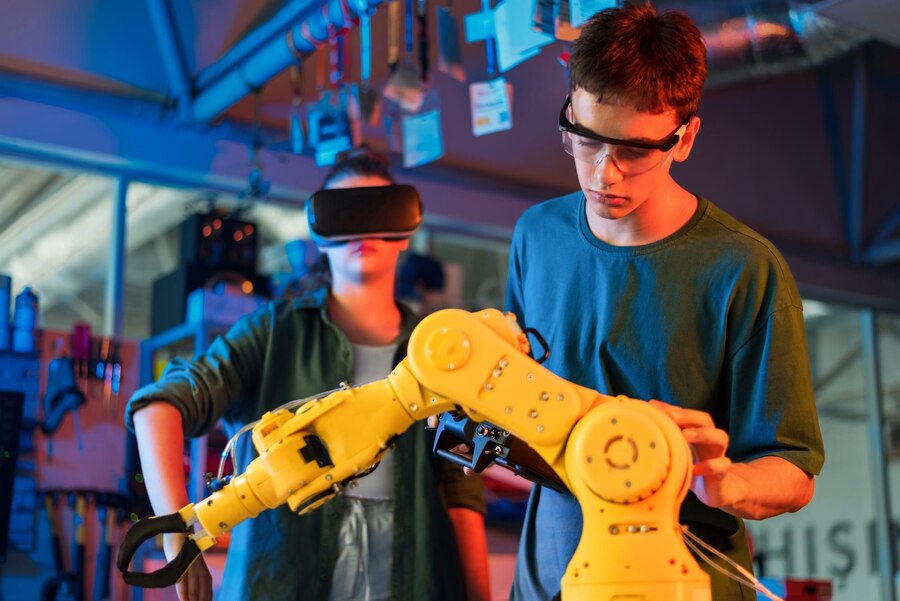Robots are no longer confined to factory floors or sci-fi blockbusters. Thanks to massive strides in AI, sensors, and mobility, next-generation robotics is quietly making its way into everyday life—from your living room to your local grocery store.
But we’re not talking about clunky machines with stiff arms. We’re talking about fluid, context-aware robots that can cook, clean, deliver, and even emotionally respond. The question isn’t “if” robots will be part of daily life—but how soon and how deeply.
Here’s a glimpse at what’s coming—and what it means for you.
1. Home Robots Are Leveling Up
Forget simple vacuum bots. The next generation of home robots are multi-functional, mobile, and much smarter.
What’s Coming:
-
Multi-tasking assistants like Samsung’s Ballie or Amazon’s Astro, which can patrol your home, control smart devices, and act as a mobile AI hub.
-
AI-powered chef bots that can prepare simple meals or assist with cooking tasks.
-
Elder care robots that help with mobility, reminders, or companionship.
These aren’t one-trick ponies—they’re personal assistants on wheels, designed to blend into your daily life.
2. Robots in Retail and Restaurants
Robots are already rolling into service industries—and not just as a novelty.
Where You’ll See Them:
-
Retail assistants helping restock shelves or guide customers (like Simbe’s Tally)
-
Delivery bots for groceries and food, operating on sidewalks or even indoors
-
Robot baristas and chefs, from pizza ovens to ramen-making arms
-
Inventory bots in warehouses, streamlining logistics with AI precision
They’re boosting efficiency, reducing labor strain, and quietly changing how goods move and services are delivered.
3. Healthcare Gets Robotic Help
The healthcare industry is facing pressure from rising demand and shrinking workforces. Robots are stepping up as force multipliers.
Key Developments:
-
Surgical robots with ultra-precise movements (like the da Vinci system)
-
Hospital delivery bots that transport meds, linens, or equipment autonomously
-
Rehabilitation robots that assist with mobility therapy
-
Care bots that monitor patients and detect changes in vitals or behavior
These bots aren’t replacing nurses or doctors—but they’re helping them focus more on care and less on logistics.
4. Companion and Education Robots for Kids (and Adults)
Think of these as friendly robots with a purpose—to teach, entertain, and engage.
What’s Emerging:
-
Language-learning bots with conversational AI
-
STEM learning companions like Miko or Cozmo that teach coding and problem-solving
-
Therapy bots designed for children with autism or seniors dealing with isolation
As AI becomes more emotionally intelligent, expect robots to take on more roles that involve empathy, not just logic.
5. Industrial Robots Meet Human Environments
Industrial bots aren’t just stuck behind cages anymore. Collaborative robots (aka cobots) are entering more workspaces, trained to work with humans, not replace them.
What to Watch:
-
Cobots helping in small manufacturing and workshops
-
Robots taking over repetitive physical tasks like lifting, sorting, or assembly
-
Integration with wearables to ensure safety and coordination
Smaller businesses can now afford automation—and that’s a game-changer.
6. Emotional Robotics and AI Companionship
This is where it gets futuristic—and a little philosophical.
On the Horizon:
-
Social robots that use voice tone, facial expressions, and behavior tracking to respond emotionally
-
Robots that can simulate companionship, memory, and personality
-
Mental health bots that offer non-judgmental conversation and check-ins
They’re not replacing human relationships—but in a lonely world, they’re becoming a new kind of connection.
7. Personal Mobility and Exoskeletons
Robots are also extending human ability, not just automating tasks.
Look for:
-
Exoskeleton suits helping with mobility, rehabilitation, or labor-intensive jobs
-
Personal transport bots (like Honda’s Uni-One) that blend robotics with futuristic wheelchairs
-
Wearables that amplify physical endurance or protect workers from strain
These innovations could change accessibility, labor safety, and independent living.
The Road Ahead: Seamless Integration
The future of robotics isn’t about flashy humanoids. It’s about invisible integration—robots that blend into our homes, workplaces, and routines so smoothly we barely notice them.
And thanks to rapid progress in AI, voice recognition, natural movement, and battery life, that future is closer than it feels.
Robots Are Coming Home
Robots are no longer tools for specialists—they’re becoming collaborators, companions, and caretakers in our everyday world. The key will be designing robots that aren’t just functional—but human-aware, safe, and intuitive to live with.
Because the question isn’t whether we’ll accept robots. It’s whether we’ll even think of them as robots at all.

